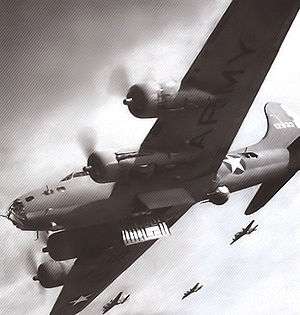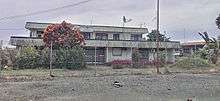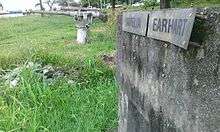Lae Airfield
Lae Airfield.svg.png) | |
|---|---|
| Part of Fifth Air Force | |
| Located in Morobe Province, Paupa New Guinea | |
 Lae Airfield | |
| Coordinates | 06°43′59″S 146°59′45″E / 6.73306°S 146.99583°E[1] |
| Type | Civilian/Military Airfield |
| Site information | |
| Controlled by | United States Army Air Forces |
| Site history | |
| Built | 1930s (prewar airport) |
| In use | 1942–1945 |

Lae Airfield is a former World War II airfield and later, civilian airport located at Lae, Morobe Province, Papua New Guinea. The airport was closed in the 1980s, in favour of Lae Nadzab Airport, which was able to accommodate larger jet aircraft. The airport was known as Lae Drome or Lae Aerodrome
History
The airport was built in 1927 and was an operating airport until 1977. The airport construction resulted in Lae becoming a major city in Papua New Guinea.
Post World War I
In 1921 when the military administration ended after World War I, a gold prospector named Cecil John Levien was appointed District Officer of Morobe. On 1 January 1923 Levien acquired a mining right for the area and shortly after formed a syndicate called Guinea Gold (No Liability).[2]
In November 1927 the Guinea Gold syndicate became Guinea Airways Limited[3] and Levien arranged for the construction of the airstrip to assist the gold mine productions around Wau.[4]
World War II
In February 1942 the airfield was occupied by the Japanese and was developed into a forward airbase. As part of the Lae defenses, the Japanese created many tunnels around the airport. During Japanese occupation they also upgraded the nearby Malahang runway to be used as a satellite of Lae Airfield.
In September 1943 the airfield was heavily bombed by Allied forces including six 65th Bombardment Squadron Boeing B-17 Flying Fortresss until its liberation in the Salamaua–Lae campaign. Encountering no anti-aircraft fire or enemy fighter opposition, the 65th BS historian wrote;
- "Bombing was excellent. The mission was uneventful".[5]
Lyndon B. Johnson was appointed Lieutenant Commander in the United States Naval Reserve on 21 June 1940. Eleven Martin B-26 Marauders of the 22nd Bombardment Group departed Townsville on 8 June 1942, arrived in Port Moresby and raided Lae on 9 June 1942. The mission was called "TOW 9" and Lieutenant Commander Lyndon Baines Johnson, the future 36th President of the United States, went on this raid as an observer on the aircraft, the Heckling Hare. [lower-alpha 1][lower-alpha 2] Nine days after the raid, Johnson was awarded a Silver Star medal for his participation in the above bombing raid.[6][7] in[8]
Post WW2
The airstrip recovered to become a significant factor in the development of post-war PNG[9]
Decommission
The old Lae airfield started losing its thunder in 1977 when Lae Nadzab Airport, a United States Air Force base, became operational. Fierce political squabbling over the pros and cons of Lae and Nadzab continued until 1982, when, in an unsolved mystery, the Lae airport terminal was burned down.[9]

Lae airfield continued to be used by Air Niugini and other third-level airlines until 1987. It was also used as the base for the Papua New Guinea Defence Force until it was transferred to Port Moresby in 1992.[9]

First flight
The first flight into the airfield was a DH-37 flown by E. A. "Pard" Mustar. The aircraft was shipped from Essendon Airport to Rabaul on the S.S. Melusia[10] and flown to Lae on 31 March 1927.
From 1922 to 1942 the airfield was part of a massive airlift operation to service the Bulolo goldfields and was one of the largest airlift operations in the world.[9] Junkers W34 tri-motor planes were ideal and the German Junkers aeroplanes played a major part in the exploration and development of what is today Papua New Guinea. To mine the gold required the construction on site of several 1500+ ton dredges with the heaviest part scaling over 3 tons.
Junkers W34 aircraft
The first Junkers W34 B, VH-UGZ (c/n 2601 CoR 195-crashed Wau 6 March 1930[11]), was bought disassembled in big crates to New Guinea and made its test flight on 10 April 1928. The first two G31s were called Peter and Paul, the third simply G31. This aircraft could carry two passengers and a ton of freight in the cargo compartment. In the first 19 days of operation the W34 No 1 earned gross revenue of £2,649 with field costs of £360. The second W34 was ordered on 8 June 1928 and arrived in December. By then No 1 W34 had carried 500 passengers and 300 tons of freight. Guinea Airways eventually purchased five of these simple, rugged and honest Junkers machines unmatched at the time by any other manufacturer. The aircraft could be loaded or unloaded in 15 minutes through a large open hatch on the roof with the gantry crane above the aircraft.[12]
Amelia Earhart

The Lae airport is probably best remembered for being the point of departure in July 1937 for Amelia Earhart and navigator Fred Noonan on their flight to Howland Island. Earhart's plane disappeared near Howland Island some 19 hours after departing Lae airport.
Allied Units based at Lae Airfield
- Headquarters, 309th Bombardment Wing (1 February – 3 March 1944) B-24 Liberator
Former Airlines
- Bulolo Goldfields Air Service
- Guinea Airways
- Morlae Airlines (Port Moresby)
- Ansett Airways
- Trans Australia Airlines
- Air Niugini
See also
References
![]() This article incorporates public domain material from the Air Force Historical Research Agency website http://www.afhra.af.mil/.
This article incorporates public domain material from the Air Force Historical Research Agency website http://www.afhra.af.mil/.
- ↑ Lae Airfield (AYLA) at Great Circle Mapper
- ↑ Kernot, C, 1999, "Valuing Mining Companies: A Guide to the Assessment and Evaluation of Assets, Performance, and Prospects" in Business and Economics CRC Press
- ↑ Australian Dictionary of Biography, Volume 10, (MUP), 1986 Levien, Cecil John (1874–1932)
- ↑ Lipscomb, A, McKinnon, R & Murray, J 1998 Lonely Planet
- ↑ Gene Eric Salecker. Fortress Against The Sun: The B-17. Da Capo Press; 2001. ISBN 0-306-81715-2. p. 365–.
- ↑ Noel Tunny (1991). Gateway to Victory: The Establishment of the First U.S. Armed Forces in Australia 1941–42 : 3rd Bomb Group (M), 7th Bomb Group (H), 19th Bomb Group (H), 22nd Bomb Group (M), 27th Bomb Group (L), 49 Fighter Group. N. Tunny. ISBN 978-0-646-08883-9.
- ↑ Michael John Claringbould (1999). The Forgotten Fifth: A Photographic Chronology of the U.S. Fifth Air Force in the Pacific in World War Two. Aerothentic Publications of Australia.
- ↑ Dunn, Peter. "Lyndon Baynes [sic] Johnson: His Time in Townsville and the Bombing Raid on Lae "Tow 9" – 9 June 1942". Oz@War. Retrieved 2 March 2014.
- 1 2 3 4 The old Lae airport, Dec 03, 2007, Malum Nalu accessed 8 Jan 2014
- ↑ Melusia SS Shuncho Maru, Wrecksite.eu accessed 8 Jan 2014
- ↑ Civil Aircraft Australia
- ↑ Linke, R 2006, The influence of German surveying on the development of New Guinea, Association of Surveyors of PNG. Accessed 25 January 2014.
Notes
- ↑ The aircraft the Heckling Hare (#40-1488) was probably named after the cartoon The Heckling Hare
- ↑ The aircraft was also known as the Arkansas Traveller